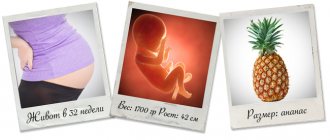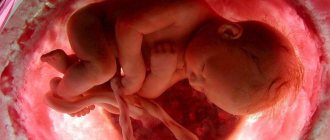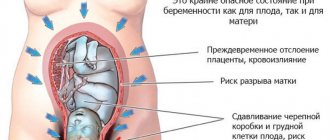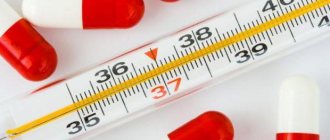It is necessary to call an ambulance for a child in several cases: if the child has a very high body temperature, convulsions, severe abdominal pain, swelling with a rash and difficulty breathing. Keep in mind that in some cases you simply cannot hesitate! After all, the sooner a child receives qualified medical care, the greater his chances of a full recovery. If the health of your child depends on the speed of your reaction, you must act decisively. And don't be afraid to play it safe! If the ambulance team is not there for half an hour, do not waste time and take the child to the nearest hospital yourself, he must be examined there! Call a taxi or hail a car on the street.
At what temperature should you call an ambulance in a child?
If a child has a common cold, the local pediatrician will prescribe treatment and the illness will soon go away. However, high fever in children often accompanies other illnesses. And in some cases you need to immediately call an ambulance.
— Against the background of a high temperature, the child begins to vomit. Theoretically, this could indicate both ordinary food poisoning and the reaction of the child’s nervous system to fever (a spasm of the esophageal sphincter occurs). However, he definitely needs urgent help! After all, vomiting sometimes indicates serious meningitis or a serious intestinal infection, in which dehydration quickly develops.
— The child developed a rash of any nature. Purple spots or a rash in the form of bruises that appear right before your eyes should be especially alarming. These are signs of meningococcemia, a dangerous infection. The child urgently needs antibiotics!
- Headache, lethargy, lethargy, drowsiness in a child with a temperature above 38.5 C is a very serious symptom, indicating a severe infection. Doctors from the ambulance team will provide first aid and take the child to the hospital.
— Fever in children can be brought down with ibuprofen or paracetamol in an age-appropriate dosage, but if you notice that the drugs do not work and the child’s temperature does not go down, call an ambulance.
Nature and cause of pain
Abdominal pain in a child can vary and can even be life-threatening. Dangerous include painful sensations caused by pancreatitis, peritonitis, appendicitis. In these cases, giving the child painkillers is strictly prohibited until the baby is examined by a doctor and makes an accurate diagnosis. It is worth mentioning separately about appendicitis, which is difficult to diagnose because it is not always accompanied by unpleasant sensations in the lower abdomen.
The first sign is if the child has a stomach ache in the navel area. Pain in the navel area after some time goes down and concentrates in the right corner of the abdomen. Further, the intensity of the pain increases and a fever may appear, the baby’s activity decreases, he refuses to eat, and vomiting may occur. A waiting position can lead to the most disastrous consequences, therefore calling a doctor and subsequent hospitalization are mandatory measures.
A child’s stomach also hurts due to infectious diseases and poisoning. Other warning symptoms include:
- spasms;
- headache;
- stool disorder;
- nausea and vomiting;
- chills or fever
The child is dehydrated
Children under 3 years of age become dehydrated much faster than adults. It is enough for them not to drink the required amount of liquid for several hours in case of high fever or vomiting. It is important to prevent dehydration in a child and know its signs so that at the slightest threat you can call an ambulance.
How to give water to a child who is dehydrated
Loss of fluid and mineral salts occurs at high temperatures, as well as with any other diseases accompanied by vomiting and diarrhea. This can be either an intestinal infection or an acetone crisis. Therefore, drinking plenty of fluids is a prerequisite for treating a child. Offer him clean water, compote, herbal tea, such as chamomile. If your child refuses to drink, add a little sugar to the drink. It is important that he drinks as much as possible during his illness. A special situation is uncontrollable vomiting. Then the child should be given water according to the following scheme: 5 ml of liquid every 5-10 minutes. This algorithm will ensure that at least some liquid is absorbed by the body. If the child categorically refuses to drink, call the emergency room!
Symptoms of dehydration in a child
A well-hydrated child should urinate every 4 hours with light-colored urine. If this occurs less frequently, it is possible that the child’s body is dehydrated. If dehydrated, he may develop bad breath, and the mucous membranes and tongue will be dry. Pronounced drowsiness or, conversely, unnatural agitation are also symptoms of dehydration in children. In children under one year old, when dehydrated, the fontanel collapses, and when crying there are no tears.
A child with dehydration must be hospitalized immediately. In the hospital, fluid loss will be replaced intravenously using a drip. However, it is in your power to prevent this from happening! Remember: it all depends on how much the child drinks when he is sick. So keep a close eye on this.
What not to do
Feed the child for the first 6 hours after severe vomiting;- Apply a heating pad with ice or hot water to your stomach;
- Carry out warm-ups;
- Flush the stomach, forcing the child to drink plenty of fluids;
- Reduce heat with vinegar rub;
- Feel and press on the abdomen yourself.
If a child complains of abdominal pain, weakness and malaise, do not ignore this fact. Don’t let the disease take its course and call an ambulance.
The child has seizures
Most often, convulsions in a child are a consequence of a sharp rise in temperature. Such seizures are called febrile and occur in 2-5% of children under 6-7 years of age. However, there is a risk of more serious illnesses, such as meningitis or another infection that affects the nervous system.
If a child has seizures before the ambulance arrives:
- Place the child on a flat surface away from sharp, heavy objects. The safest position is this: the child lies on his side, his head turned down. This position prevents saliva from entering the respiratory tract. But you don’t need to put anything into your child’s mouth yourself.
- try to remember the duration of the attack and its external manifestations. This information will be useful to the doctor to make the correct diagnosis and help determine the tactics for further examination and treatment. Pay attention to the following points: the presence of consciousness (whether the child reacts to anything during seizures), posture, position of the torso and limbs. The main thing is don’t panic!
The child has an immediate allergy
Allergies in a child can manifest themselves in the form of skin rashes. Or more menacingly - in the form of anaphylactic shock or Quincke's edema. An extreme allergic reaction can be triggered either by contact with a medicinal allergen (most often antibiotics) or by an insect bite. It is important not to get confused and quickly call an ambulance for your child.
Anaphylactic shock in children
The first symptoms of incipient anaphylactic shock are a feeling of fear in a child, a throbbing headache, numbness of the lips and face, dizziness, tinnitus, vomiting, cold sweat, and urticaria. Before the doctors arrive, place the child on a flat surface. Keep his head turned to the side and make sure that no vomit enters the airway. Keep your child warm and provide him with access to fresh air.
Quincke's edema in children
The child's face (eyelids, nose, ears, tongue) suddenly swells and turns red. Swelling can also be localized on the genitals, hands, and feet. Until the ambulance arrives, give the child an antihistamine in an age-appropriate dosage. To quickly remove the allergen from the body (usually insect venom), give the child water and some sorbent (smecta, enterosgel). And keep calm! The doctors know what to do and they will definitely help the child.
What to do if your child has a stomach ache
Before the doctor arrives, you must provide assistance to the child yourself. To alleviate the baby’s condition and avoid complications, urgent measures should be taken.
How to help if your child has a stomach ache:
- Hold him in your arms.
- Perform stroking the abdomen, moving clockwise.
- Carrying the baby vertically (in the form of a column), this will provoke belching of air.
- If there is colic, the child is placed on his back, his legs are bent at the knees, slightly pressed against his stomach, and then they are straightened, repeating the movements.
- Give your baby dill water.
- A tube to remove gases will help with bloating, but without fanaticism.
- In case of constipation, do an enema.
What measures to take for abdominal pain in a child of any age:
- Invite a doctor.
- Do not take pain medications.
- Avoid pressing on the stomach, do not touch it at all.
- Give the child water (a teaspoon or a tablespoon at a time, depending on the age category of the child) at intervals of 5 minutes.
- You should not heat the abdominal area, as this can lead to bad consequences.
- Apply ice to the sore spot.
- If abdominal pain is accompanied by vomiting, delay eating until examined by a doctor.
- If diarrhea and vomiting occur with abdominal pain, these masses should be collected; their analysis will help the doctor quickly determine the diagnosis.
If you have absolute confidence that your child’s stomach pain is due to food intake and not due to another illness, it is important to decide on the medications that should be given to the patient based on the symptoms:
- Espumisan, Disflatil will help with intestinal bloating;
- To cope with pain after eating: Enterosgel, Festal, Mezim;
- for diarrhea: Gastrolit, Linex, Regidron, Laktovit;
- for overeating: Creon, Fesial, Mezim;
- for heartburn: Maaloxom, Almagel, Rennie;
- in all cases: No-shpa;
- for food poisoning: Smecta, Enterodes.
Child has abdominal pain
Children complain of abdominal pain for various reasons. Most often, the child ate something wrong. But acute pain cannot be confused with anything. The child is holding his stomach and crying a lot. You can't give in to emotions now. You need to call an ambulance. First of all, doctors are obliged to exclude surgical pathology - appendicitis or volvulus.
Appendicitis in children
Inflammation of the appendix is a fairly rare occurrence in children under 3 years of age. However, you should still play it safe and agree to be examined by a surgeon in the hospital. After all, in this case there is only one treatment - surgery, which needs to be done as quickly as possible. Never give your child antispasmodics or painkillers before the doctor makes a diagnosis. The antispasmodic will alleviate the child’s condition, but it will be difficult for the doctor to determine what happened to the child. But the sorbent - smecta or enterosgel - will not harm, but, on the contrary, will help get rid of toxins if abdominal pain is caused by an intestinal infection.
Volvulus in children
Intussusception (volvulus) - the penetration of one part of the intestine into the lumen of another - occurs in 90% of cases in children under one year of age. The child screams loudly, cries, draws in his legs, turns pale, and refuses to eat. The attack of anxiety ends as suddenly as it begins, but after 5-10 minutes it repeats. It is typical that during the “light period” the child feels absolutely normal, smiles and plays. But a few hours after the onset of the disease, the child begins to vomit profusely with an admixture of bile. There is a lot of mucus and blood in the baby's stool. Call an ambulance urgently! Qualified care for a child can only be provided in a surgical hospital. Don't worry, surgery is not always indicated. There are many chances that doctors will cope with intussusception in a conservative way.
the child has a stomach ache and fever
There are a large number of diseases that are accompanied by abdominal pain. By nature, acute, chronic and recurrent abdominal pain is distinguished.
Acute abdominal pain can be a consequence of acute surgical pathology, trauma, acute infectious disease or food poisoning.
Much more often there are patients with complaints of recurrent abdominal pain.
Abdominal pain (abdominal pain) is the most common symptom
- for diseases of the gastrointestinal tract (stomach, pancreas, intestines, liver, gall bladder);
- for kidney diseases;
- for diseases of the pelvic organs.
In healthy people, as a rule, abdominal pain appears when overeating or excessive gas formation. Such pain does not require any special treatment; it goes away on its own within a few hours or a day.
What not to do if you have severe abdominal pain?
- You should not take painkillers - this will make it difficult to determine the true cause of abdominal pain
- Do not apply a warm heating pad to your stomach
- Do not take laxatives
- Under no circumstances should you administer enemas yourself.
— The patient with severe abdominal pain should refrain from eating and drinking
If within 2-4 hours the child’s condition becomes worse (abdominal pain intensifies), then you need to call a doctor (ambulance).
Appendicitis
Appendicitis occurs in one in six children. Rarely occurs in children under 2 years of age. Removing the appendix is one of the most common operations in children.
Appendicitis can be suspected by the following signs:
- children lose their appetite,
- periodically there is nausea, weakness and fatigue,
- sometimes the body temperature rises slightly.
In some cases, there is pain around the navel, which lasts for several hours, then intensifies and is localized in the lower abdomen on the right. The pain intensifies, the child tries to lie down with his legs brought to his stomach. Appendicitis may be accompanied by constipation or slight diarrhea. There is severe pain when touched in the lower right side of the abdomen. If such signs are present, the child should be urgently taken to the hospital.
Intestinal infection
Gastroenteritis (intestinal infection) begins with nausea, vomiting, fever and paroxysmal pain. Later diarrhea appears. The pain intensifies before and after eating. Often other family members have similar symptoms of the disease.
Hypothermia and sore throat occur in young children several times a year. Viruses and bacteria cause inflammation not only of the lymph nodes of the neck, but also of the intestinal mesentery. Sometimes the abdominal pain is severe, similar to the pain of appendicitis.
Pain in the throat and abdomen can also accompany infectious mononucleosis and so-called enterovirus infections.
In 4-5% of cases, periodically occurring severe abdominal pain in children is accompanied by nausea and vomiting, but is not associated with poisoning or intestinal infection and may be a consequence of intestinal vasospasm (abdominal migraine). In case of such pain, the child should be shown to a neurologist.
Gastritis and gastroduodenitis
Pain that occurs immediately or within 20-30 minutes after eating indicates diseases of the esophagus and stomach. Night pain, “hungry”, passing after eating or occurring 1-2 hours after eating indicate a slow evacuation of gastric contents and diseases of the duodenum (including peptic ulcer). If the digestive processes are disrupted or if there are diseases of the small intestine, pain often occurs after eating fresh fruits and vegetables, mainly in the evening.
When a child has such complaints, the first rule for parents should be the child’s daily routine. Primary school children should go to bed at 21.00, senior schoolchildren - at 22.00. Younger schoolchildren must have time for naps during the day. All children should have the opportunity to go out and play after school. It is important to remember about 3 hot meals a day. If there is no hot food for breakfast at school, then you need to feed the child at home. If a child is additionally involved in clubs or sections, he should have time to have a quiet lunch. Do not allow children to eat at night; they should have dinner 1.5-2 hours before bedtime.
Parents should explain to their child why it is bad to consume fast food, chips, and carbonated drinks. If abdominal pain periodically recurs in a child for 2-3 months, this should alert parents: does the child have chronic gastritis and is it time to see a doctor?
A common cause of long-term abdominal pain in children is constipation. Constipation disrupts the functioning of the intestines and manifests itself as pain in the form of colic.
Kidney inflammation
Kidney inflammation occurs more often in girls and begins with pain in the side or lower back. Children urinate frequently and experience fever, nausea, and vomiting. In case of such symptoms, the child should be shown to a urologist.
Abdominal muscle strain
Stretching the abdominal muscles occurs due to excessive exercise, coughing or vomiting. Pain occurs only when walking or if the child tries to sit upright. The pain is sudden and sharp (unlike gastroenteritis, when the pain is dull). The general condition is not disturbed, good appetite remains.
Psychological problems
Psychological problems occur in 10% of school-age children. In 90% of cases, it is impossible to identify any physical cause of pain. They are caused by experiences, stress or other psychological factors. Children describe in these cases a dull pain around the navel that appears and disappears. Such children are usually pale, tired, and have headaches and nausea. Although in most cases these phenomena resolve spontaneously, it is necessary to monitor the child so as not to miss any disease. Abdominal pain due to psychological reasons can sometimes be quite severe, so pay more attention to your child and try to find out the cause. Sometimes it is necessary to consult a psychotherapist and talk with teachers at school.
Acute pyelonephritis in children
Urinary tract infection - pyelonephritis in children - can begin with a high temperature (more than 38.5 0C) without other signs of illness. However, this is not yet a reason to be nervous. You need to call a pediatrician. But if a child has difficulty writing against the background of a fever, or has pain in the abdomen or lower back, immediately call an ambulance.
Symptoms of pyelonephritis in children
With pyelonephritis, it is almost always difficult for a child to write. Moreover, this can manifest itself in different ways. There are delays in urination, and, on the contrary, frequent urges. Urine is usually very dark and cloudy. Sometimes it hurts for a child to go to the toilet; he cries even at the sight of a potty. All this is a reason to suspect pyelonephritis in children - inflammation of the kidney tissue due to a bacterial infection.
- It is advisable to prepare the child’s urine for analysis before the ambulance arrives. Wash it well with soap and collect the urine from a medium stream into a sterile glass container (it is best to boil the container first). To prescribe precise treatment and monitor its progress, doctors will need bacteriological urine culture. And it must be done before taking antibiotics, which the baby will be prescribed in the hospital, because antibacterial drugs will blur the picture. So you will undoubtedly help the doctors and the child if you take care of the test in advance.
- Before the ambulance arrives, ibuprofen in an age-appropriate dosage will help alleviate the child’s condition. It has not only an antipyretic, but also an analgesic effect.
Possible causes of pathology
- Appendicitis. Most often, the phenomenon occurs in children aged 9-13 years, and the older they are, the more severe the symptoms. If appendicitis occurs in the first year of life, the child’s behavior will immediately change: he will become restless and whiny. At older ages, complaints of cramping spasms and pain in the navel are common. Relief occurs when the patient lies on his side and tucks his legs. When you press on your stomach, the pain becomes unbearable. The temperature rises to 38 degrees.
- Peritonitis (can be abacterial and streptococcal). The pathology is rare, since in the treatment of influenza and sore throat, antibiotics are prescribed that “kill” this infection. Symptoms will be high temperature (up to 40 degrees), pain near the navel and throughout the abdomen, nausea, vomiting. Loose stools may be observed, and their color will most likely be green and the smell will be very pungent.
- Viral diseases. Appear due to the penetration of viral rods into the body. The child may have a high fever, and the pain may be localized either in one area, for example, the umbilical area, or spread throughout the entire abdomen. Another symptom is diarrhea, accompanied by a specific odor. There may be blood and mucus in the stool. Children under 2 years of age should begin treatment as early as possible to avoid dehydration.
- Inflammation of the kidneys (acute pyelonephritis). In this case, the temperature jumps sharply, there are chills, profuse sweating, pain in the lower back and abdomen, and discomfort when urinating.
- Poisoning with food, low-quality milk formula, and medications.
In addition, the stomach can hurt not only due to pathologies of the abdominal cavity, but also as a result of other diseases:
- Sore throat (tonsillitis). The first symptoms will be fever, chills, sore throat, and aches. In acute tonsillitis, severe colic in the abdomen is often observed.
- ARVI, diphtheria and other infectious diseases. Temperature readings will depend on the disease. For some, there is a slight increase, for others the thermometer simply “boils.” With such ailments, the stomach hurts due to enlarged lymph nodes. The symptoms are sometimes similar to appendicitis, but with infectious diseases the child will complain of a runny nose, cough, and discomfort in the throat.
- Inflammation of the lungs (pneumonia). Cough and temperature of 38 and above are accompanied by pain in the peritoneum, which intensifies with inspiration. Nausea and vomiting are possible.
- Pancreatitis. Sharp pain is observed in the left upper abdomen. Then unpleasant sensations begin to surround the entire body, radiating to the back. Temperatures can reach 38 degrees. The child often vomits, which is difficult to stop.
The child has difficulty breathing
Shortness of breath almost always accompanies high fever in children. However, the mother needs to know in which cases, if the child has breathing problems, urgent help is required.
Respiratory failure in children.
This condition can develop both with pneumonia and with severe obstructive bronchitis. The nasolabial triangle on the baby’s face turns blue, it feels like he is fighting for every breath. Breathing may become very loud and rapid. Don't waste time, call the emergency room!
Foreign body in a child.
A child may choke on a piece of food or accidentally inhale a small object. A foreign body in a child’s respiratory tract is manifested by an annoying cough that does not stop even at night. It feels like the child is trying to clear his throat. Call an ambulance if this continues for more than two to three hours. In the hospital, the child will have a chest x-ray.
False croup in children
Some viral colds can cause croup, which is inflammation and swelling of the larynx. Children with allergies are at risk. Croup, or stenosing laryngotracheitis, develops more often due to a combination of causes: penetration of a virus and an allergen into the respiratory tract.
Symptoms of false croup in children
The child begins to have a frequent, barking, dry cough; when inhaling air, a loud whistling sound is heard. The child is afraid, and this further aggravates his condition. Before the doctors arrive, your first priority is to calm your baby. Sit him on your lap, hug him tightly, try not to be nervous, because your emotions are transmitted to the child.
Provide a flow of fresh air into the room. Open all the windows wide or even go outside with your son or daughter. The main thing is to make it easier for the child to breathe.
Inhaling a soda solution will also relieve laryngeal spasms in children. While you are calming your child, ask your husband to dissolve a pack of soda in a warm bath. Let the child breathe this moist air until paramedics arrive. By the way, if you do everything correctly, the attack of false croup will end in 20-30 minutes. And then the ambulance will arrive.
Remember: if a child has a spasm of the larynx, mustard plasters, warming ointments for the chest and back, and aromatic oils are contraindicated. And also excessive parental nervousness. Before the doctor arrives, an inhaler-nebulizer will help with an attack of false croup in a child. Check with your doctor which model is preferable in your case and what medicinal solutions should be used. But in any case, call an ambulance at the first sign of difficulty breathing in children.











